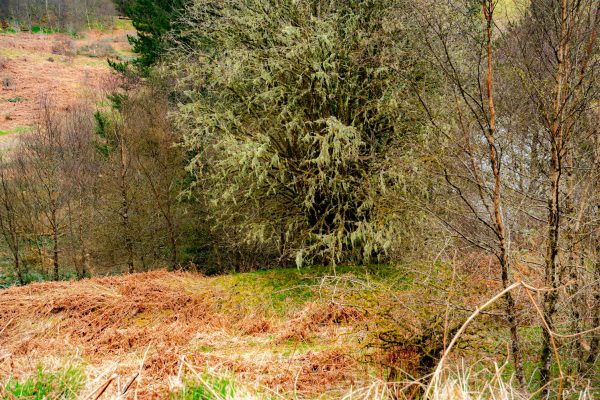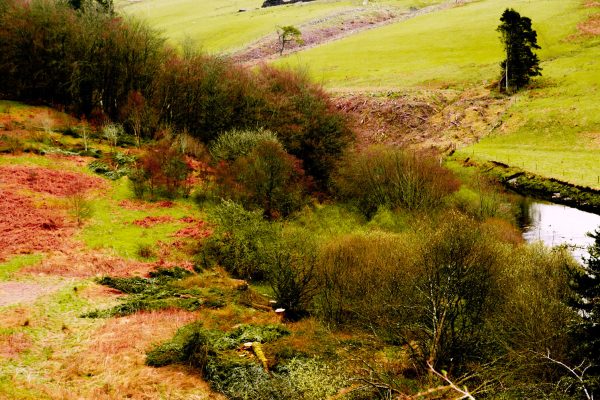Over Rig
"Amphitheatre"
1. Boonies: A Romano-British farmstead
2. Bailiehill: A Magnificent hill citadel
3. The Knowe: A fortlet, farm or fortified croft
4. Castle O’er: The most superb of the Esk Valley hill forts
5. Over Rig: A unique and perplexing site – fascinating but mysterious
6. Bessie’s Hill: A fort and enclosure
7. The Loupin’ Stanes: A small but impressive stone ring
8. The Girdle Stanes: A large stone ring
9. King Schaw’s Grave: A burial kist, once buried under a vast cairn
This site was excavated by Richard Bell of Castle O’er in the 1890s, and more recently by Roger Mercer in 1984-5, as the White Esk river threatened to erode the site (the threat is still there).
This is a puzzling site, with nothing quite like it anywhere else in Britain, and it is not at all clear what kind of things happened here.
Looking around, this is certainly not a site where our ancestors would choose to live permanently, nor was it a site suitable for defence. However it is a natural amphitheatre so that it is tempting to think of some kind of happening with spectators. During the 1984-5 excavations Mercer and his colleagues were impressed by the excellent acoustics of the site. Try them out for yourself!
Richard Bell writes –
“About half a mile to the north of Castle O’er house is another work of the same formation as the minor forts: it is marked on the Ordnance map as a fort, though from its position it is badly adapted for defensive purposes.
Differing in position from the others, it lies in a hollow on a piece of flat ground close to the river bank,- so close that the river has reduced it from its original round form to that of a semicircle; and it is commanded on its west side by a semicircle of very steep ground, which must have rendered it subject to easy attack from that direction.
Mr Francis Lynn, F.S.A., Galashiels, who has devoted many years of his life to the exploration of forts and trenches in the south of Scotland and north of England, tells me that it is unique in his experience, both as to its undefended position and to this peculiarity – that its floor is raised higher than the ground outside the inner trench. He suggests that it may have been used as an arena for athletic sports, the spectators looking on from the surrounding slopes.
I was more inclined to accept the opinion of Mr Barbour, that it might have been the cemetery of the main fort, especially as one of the trenches leads directly from one to the other. On making excavations, we found that the subsoil of the work is blue clay; upon this clay logs of wood have evidently been laid to form a floor. The logs themselves have decayed away, but the bark remains, and I scarcely think that layers of bark alone had been used, as it would have been too thin and yielding for the purpose. On the top of this wooden floor is a superior one formed with rough stones, laid with their flat side down, and at the present day about eighteen inches of peat have accumulated on the top of all.
On a space forty feet in diameter, in the centre of the work, we came upon a heap of rough stones eighteen inches thick; and below this, resting upon a layer of charred wood mixed with the clay, was a great quantity of minute fragments of bones, which had evidently been subjected to the action of fire.
If these bones were human, I hoped that Mr Barbour’s suggestion that this was the cemetery or “crematorium” of the main fort might be sustained, – though it was not quite obvious why a cemetery, or an arena for athletic games, should require for their protection strong and wide-apart earthworks. However, on submitting specimens of the bones to Professor Struthers, Royal College of Surgeons, Edinburgh, for his opinion, he said that, without being able to declare that they were not human, he inclined to think they were those of some of the lower animals.
I fear, therefore, in the face of such an opinion, the crematorium theory must be abandoned, and the question still remains, What was it?”
About 90 years later Roger Mercer found that the blanket-peat on the “floor” of the amphitheatre had been covered with a “raft” of blue clay obtained from the bottom of the ditch – perhaps as a damp-proof course? On the “floor” was a trapezoidal arrangement of stones about 4 metres across. Broken whetstones and a quantity of coal and slag suggest some kind of industrial process. Other finds during excavation included wooden daggers and glass beads from bracelets. At this later excavation no animal or human bones were found to suggest either feasting or interment.
As Richard Bell asks, What was it? Will we ever know?






